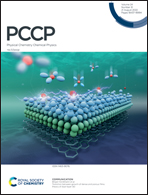Excited state dynamics of a spontaneously generated TTF radical cation inside a water-soluble nanocage†
Abstract
Supramolecular cavities have been traditionally used to stabilize reactive redox intermediates. Recently with the success of multiple new photoredox catalytic strategies that use supramolecular cages, there is a growing demand for photogeneration strategies of diverse reactive intermediates inside confined spaces, which will drive enzyme-like catalysis in real time. Here we report the excited state dynamics of a redox-active TTF radical cation and its corresponding dimethyl-derivative DiMeTTF inside a confined supramolecular cavity. We prepare the radical cation by spontaneous oxidation of neutral TTF upon incarceration inside a water-soluble nanocage Pd6L412+, and characterize it with a combination of resonance Raman and electron paramagnetic resonance spectroscopy. Using broadband transient absorption spectroscopy, we demonstrate that the confined native TTF radical cation and its dimethyl derivative upon photoexcitation rapidly de-excite to form the hot ground state, thereby inhibiting further oxidation to a TTF+2 dication. We discuss our results in the context of excited state crossings of the radical cation potentials as well as modifying the cage energetics to generate a stable dication. Our work has important implications for the usage of such radical cations for photoactivated catalysis.



 Please wait while we load your content...
Please wait while we load your content...